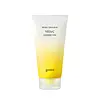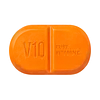What's inside
What's inside
 Key Ingredients
Key Ingredients

 Benefits
Benefits

 Concerns
Concerns

 Ingredients Side-by-side
Ingredients Side-by-side

Water
Skin ConditioningGlycerin
HumectantStearic Acid
CleansingMyristic Acid
CleansingPotassium Hydroxide
BufferingLauric Acid
CleansingPalmitic Acid
EmollientCocamidopropyl Betaine
CleansingPotassium Cocoate
EmulsifyingCitrus Tangerina Extract
TonicMelia Azadirachta Flower Extract
Skin ConditioningCitrus Aurantium Bergamia Fruit Oil
MaskingMelia Azadirachta Leaf Extract
Skin ConditioningCitrus Limon Peel Oil
MaskingCurcuma Longa Root Extract
MaskingOcimum Sanctum Leaf Extract
Skin ConditioningCitrus Aurantium Dulcis Peel Oil
MaskingQuillaja Saponaria Bark Extract
CleansingCorallina Officinalis Extract
Skin ConditioningHyaluronic Acid
HumectantHydrolyzed Hyaluronic Acid
HumectantSodium Hyaluronate
HumectantButylene Glycol
HumectantCoco-Glucoside
CleansingGlyceryl Stearate Se
EmulsifyingPolyquaternium-7
Sodium Chloride
MaskingGuar Hydroxypropyltrimonium Chloride
Skin ConditioningArachidic Acid
CleansingSodium Cocoyl Isethionate
CleansingCitric Acid
Buffering1,2-Hexanediol
Skin ConditioningSodium Phytate
Oleic Acid
Emollient3-O-Ethyl Ascorbic Acid
Skin ConditioningArbutin
AntioxidantNiacinamide
SmoothingEthylhexylglycerin
Skin ConditioningSodium Benzoate
MaskingLimonene
PerfumingLinalool
PerfumingWater, Glycerin, Stearic Acid, Myristic Acid, Potassium Hydroxide, Lauric Acid, Palmitic Acid, Cocamidopropyl Betaine, Potassium Cocoate, Citrus Tangerina Extract, Melia Azadirachta Flower Extract, Citrus Aurantium Bergamia Fruit Oil, Melia Azadirachta Leaf Extract, Citrus Limon Peel Oil, Curcuma Longa Root Extract, Ocimum Sanctum Leaf Extract, Citrus Aurantium Dulcis Peel Oil, Quillaja Saponaria Bark Extract, Corallina Officinalis Extract, Hyaluronic Acid, Hydrolyzed Hyaluronic Acid, Sodium Hyaluronate, Butylene Glycol, Coco-Glucoside, Glyceryl Stearate Se, Polyquaternium-7, Sodium Chloride, Guar Hydroxypropyltrimonium Chloride, Arachidic Acid, Sodium Cocoyl Isethionate, Citric Acid, 1,2-Hexanediol, Sodium Phytate, Oleic Acid, 3-O-Ethyl Ascorbic Acid, Arbutin, Niacinamide, Ethylhexylglycerin, Sodium Benzoate, Limonene, Linalool
Glycerin
HumectantWater
Skin ConditioningPropylene Glycol
HumectantSodium Palmitate
CleansingSodium Stearate
CleansingPotassium Laurate
EmulsifyingSodium Laurate
CleansingCoco-Betaine
CleansingDisodium Laureth Sulfosuccinate
CleansingSucrose
HumectantSorbitol
HumectantDecyl Glucoside
CleansingAscorbic Acid
AntioxidantNiacinamide
SmoothingStearic Acid
CleansingParfum
MaskingIlex Paraguariensis Leaf Extract
PerfumingPunica Granatum Extract
AstringentSchisandra Chinensis Fruit Extract
Skin ConditioningChamomilla Recutita Flower Extract
MaskingTricholoma Matsutake Extract
Skin ConditioningCitrus Limon Peel Oil
MaskingCitrus Reticulata Peel Oil
MaskingTocopherol
AntioxidantTocopheryl Acetate
AntioxidantCapsicum Annuum Fruit Powder
Skin ConditioningRosa Canina Fruit Oil
EmollientVitis Vinifera Seed Oil
EmollientFragaria Ananassa Fruit Powder
Skin ConditioningRiboflavin
Cosmetic ColorantCalcium Pantothenate
Inositol
HumectantFolic Acid
Skin ConditioningDisodium EDTA
Biotin
AntiseborrhoeicCyanocobalamin
Skin ConditioningLimonene
PerfumingLinalool
PerfumingGlycerin, Water, Propylene Glycol, Sodium Palmitate, Sodium Stearate, Potassium Laurate, Sodium Laurate, Coco-Betaine, Disodium Laureth Sulfosuccinate, Sucrose, Sorbitol, Decyl Glucoside, Ascorbic Acid, Niacinamide, Stearic Acid, Parfum, Ilex Paraguariensis Leaf Extract, Punica Granatum Extract, Schisandra Chinensis Fruit Extract, Chamomilla Recutita Flower Extract, Tricholoma Matsutake Extract, Citrus Limon Peel Oil, Citrus Reticulata Peel Oil, Tocopherol, Tocopheryl Acetate, Capsicum Annuum Fruit Powder, Rosa Canina Fruit Oil, Vitis Vinifera Seed Oil, Fragaria Ananassa Fruit Powder, Riboflavin, Calcium Pantothenate, Inositol, Folic Acid, Disodium EDTA, Biotin, Cyanocobalamin, Limonene, Linalool
 Reviews
Reviews

Ingredients Explained
These ingredients are found in both products.
Ingredients higher up in an ingredient list are typically present in a larger amount.
Citrus Limon Peel Oil is created from the peels of the lemon. It is used to add a lemon-scent to products. Lemon peel oil also has antibacterial, antifungal, and antioxidant properties. However, it may also cause phototoxicity and sensitize skin.
Lemon peel oil contains limonene, a skin sensitizing ingredient. Another component is furanocoumarin, which induces phototoxicity in skin.
Furanocoumarins bind and destabilize your DNA to increase the rate of sunburn.
Most reputable companies will remove furanocoumarins from their formulations.
Learn more about Citrus Limon Peel OilGlycerin is already naturally found in your skin. It helps moisturize and protect your skin.
A study from 2016 found glycerin to be more effective as a humectant than AHAs and hyaluronic acid.
As a humectant, it helps the skin stay hydrated by pulling moisture to your skin. The low molecular weight of glycerin allows it to pull moisture into the deeper layers of your skin.
Hydrated skin improves your skin barrier; Your skin barrier helps protect against irritants and bacteria.
Glycerin has also been found to have antimicrobial and antiviral properties. Due to these properties, glycerin is often used in wound and burn treatments.
In cosmetics, glycerin is usually derived from plants such as soybean or palm. However, it can also be sourced from animals, such as tallow or animal fat.
This ingredient is organic, colorless, odorless, and non-toxic.
Glycerin is the name for this ingredient in American English. British English uses Glycerol/Glycerine.
Learn more about GlycerinLimonene is a fragrance that adds scent and taste to a formulation.
It's found in the peel oil of citrus fruits and other plants such as lavender and eucalyptus. The scent of limonene is generally described as "sweet citrus".
Limonene acts as an antioxidant, meaning it helps neutralize free radicals.
When exposed to air, oxidized limonene may sensitize the skin. Because of this, limonene is often avoided by people with sensitive skin.
The term 'fragrance' is not regulated in many countries. In many cases, it is up to the brand to define this term. For instance, many brands choose to label themselves as "fragrance-free" because they are not using synthetic fragrances. However, their products may still contain ingredients such as essential oils that are considered a fragrance.
Learn more about LimoneneLinalool is a fragrance and helps add scent to products. It's derived from common plants such as cinnamon, mint, citrus, and lavender.
Like Limonene, this ingredient oxidizes when exposed to air. Oxidized linalool can cause allergies and skin sensitivity.
This ingredient has a scent that is floral, spicy tropical, and citrus-like.
Learn more about LinaloolNiacinamide is a multitasking form of vitamin B3 that strengthens the skin barrier, reduces pores and dark spots, regulates oil, and improves signs of aging.
And the best part? It's gentle and well-tolerated by most skin types, including sensitive and reactive skin.
You might have heard of "niacin flush", or the reddening of skin that causes itchiness. Niacinamide has not been found to cause this.
In very rare cases, some individuals may not be able to tolerate niacinamide at all or experience an allergic reaction to it.
If you are experiencing flaking, irritation, and dryness with this ingredient, be sure to double check all your products as this ingredient can be found in all categories of skincare.
When incorporating niacinamide into your routine, look out for concentration amounts. Typically, 5% niacinamide provides benefits such as fading dark spots. However, if you have sensitive skin, it is better to begin with a smaller concentration.
When you apply niacinamide to your skin, your body converts it into nicotinamide adenine dinucleotide (NAD). NAD is an essential coenzyme that is already found in your cells as "fuel" and powers countless biological processes.
In your skin, NAD helps repair cell damage, produce new healthy cells, support collagen production, strengthen the skin barrier, and fight environmental stressors (like UV and pollution).
Our natural NAD levels start to decline with age, leading to slower skin repair, visible aging, and a weaker skin barrier. By providing your skin niacinamide, you're recharging your skin's NAD levels. This leads to stronger, healthier, and younger looking skin.
Another name for vitamin B3 is nicotinamide. This vitamin is water-soluble and our bodies don't store it. We obtain Vitamin B3 from either food or skincare. Meat, fish, wheat, yeast, and leafy greens contain vitamin B3.
The type of niacinamide used in skincare is synthetically created.
Learn more about NiacinamideStearic Acid is a fatty acid. It is an emollient, emulsifier, and texture enhancer.
As an emollient, stearic acid helps soften skin. It aids the skin's protective barrier by preventing water loss. It also provides a gentle cleansing effect without stripping away natural oils.
Stearic acid may also be used to enhance the texture of products. It can add volume and stabilize ingredients such as water and oil. This can help water and oil ingredients from separating.
Sources of stearic acid include animal or vegetable fats/oils such as coconut or shea. It can be naturally found in butter, cocoa butter, shea butter, vegetable fats, and animal tallow.
This ingredient may not be Malassezia folliculitis, or fungal-acne safe.
Learn more about Stearic AcidWater. It's the most common cosmetic ingredient of all. You'll usually see it at the top of ingredient lists, meaning that it makes up the largest part of the product.
So why is it so popular? Water most often acts as a solvent - this means that it helps dissolve other ingredients into the formulation.
You'll also recognize water as that liquid we all need to stay alive. If you see this, drink a glass of water. Stay hydrated!
Learn more about Water